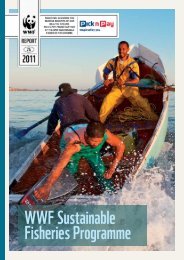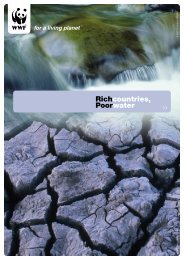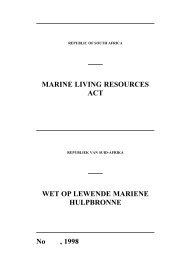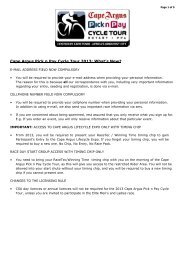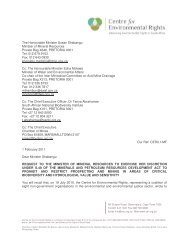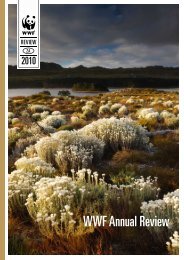State of Management of South Africaââ¬â¢s ... - WWF South Africa
State of Management of South Africaââ¬â¢s ... - WWF South Africa
State of Management of South Africaââ¬â¢s ... - WWF South Africa
- No tags were found...
You also want an ePaper? Increase the reach of your titles
YUMPU automatically turns print PDFs into web optimized ePapers that Google loves.
STATE OF MANAGEMENT OF SOUTH AFRICA’S MARINE PROTECTED AREAStool which encompasses a whole range <strong>of</strong> management options’ and presented a number <strong>of</strong>characteristics <strong>of</strong> MPAs based on several case studies. These included:The management <strong>of</strong> MPAs should be adaptive and the degree <strong>of</strong> flexibility <strong>of</strong> theMPA should be defined at the outsetMPAs are successful at different scales (large marine ecosystem scale to very smallno-take areas aimed at protecting representative areas <strong>of</strong> habitat and the associatedspecies)Ballantine and Langlois’ (2008) described MPAs, as:‘user-orientated, knowledge-based, locality-dependent, problem-solving extensions <strong>of</strong>standard marine planning and management’ that aim to ‘make human activities moreefficient and more sustainable’.This description expands on the perception <strong>of</strong> MPAs as a ‘tool with a range <strong>of</strong> managementoptions’ as it emphasises that the design, planning and management approaches applied toa MPA should be ‘tailor made’ to that area based on the circumstances in the area.The work on developing typologies for protected areas and MPAs highlights an internationalconsensus that protected areas, with the primary objective <strong>of</strong> conservation, may use differentmanagement objectives in order to achieve this end. The IUCN described six categories forprotected areas based on a range <strong>of</strong> management objectives (refer to Table 1.1). Thistypology was designed to promote international understanding and international standards,and to provide a tool to develop a representative network <strong>of</strong> protected areas, and aframework for data collection. The IUCN further developed this typology in their application <strong>of</strong>the seven IUCN protected area categories to MPAs (UNEP-WCMC 2008).Table 1.1: IUCN protected area categories (IUCN, 1994)Category I ACategory I BCategory IICategory IIICategory IVCategory VCategory VIProtected area managed mainly for science (Strict Nature Reserve);Protected area managed mainly for wilderness protection (Wilderness Area);Protected area managed mainly for ecosystem protection and recreation (National Park);Protected area managed mainly for conservation <strong>of</strong> specific natural features (NaturalMonument);Protected area managed mainly for conservation through management intervention(Habitat/Species <strong>Management</strong> Area);Protected area managed mainly for landscape/seascape conservation and recreation(Protected Landscape/Seascape);Protected area managed mainly for the sustainable use <strong>of</strong> natural ecosystems (ManagedResource Protected Area).Furthermore, both the IUCN and the CBD recommend that protected area systemsincorporate a range <strong>of</strong> types <strong>of</strong> management areas. No-take areas, multiple-use MPAs,community managed areas, World Heritage Sites, Biosphere Reserves, Ramsar Sites,fishery management areas, seasonal and temporal management areas, whale sanctuariesand mangrove forest reserves have all been listed as management areas that are likely to becommon elements in systems <strong>of</strong> MPAs (UNEP-WCMC 2008).Pg 4






